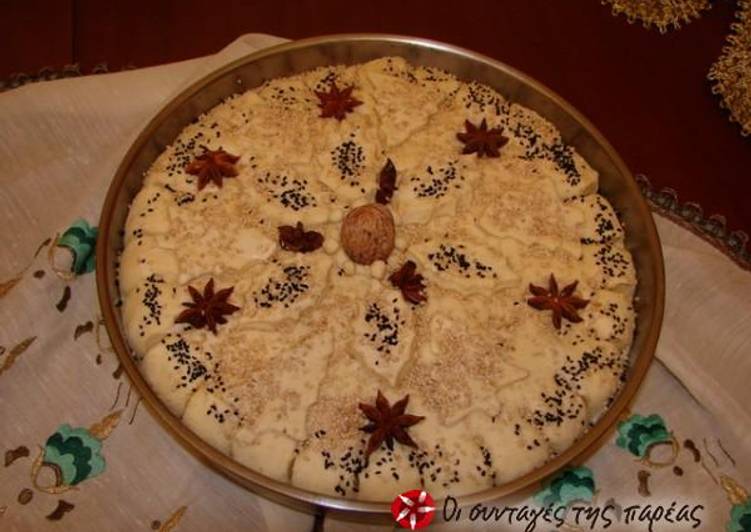Christopsomo, loaf. Christopsomo (Greek Christmas bread, the so called "bread of Christ") the decorative bread for the Christmas dinner, with it's crust. Making Christopsomo (Christ's Bread) is considered a sacred undertaking. Great care is taken with making the dough and decorating the loaves.
 I am hosting a (hopefully) traditional Greek Christmas eve dinner and wanted to make Christopsomos. "Christopsomo" in Greek means "Christ's Bread" and this is why the bread is decorated with a cross. Christopsomo is considered very sacred in Greek households and is made with great care to ensure. Christopsomo, which translates as "Christ's Bread"- pron. You can have Christopsomo, loaf using 10 ingredients and 14 steps. Here is how you achieve it.
I am hosting a (hopefully) traditional Greek Christmas eve dinner and wanted to make Christopsomos. "Christopsomo" in Greek means "Christ's Bread" and this is why the bread is decorated with a cross. Christopsomo is considered very sacred in Greek households and is made with great care to ensure. Christopsomo, which translates as "Christ's Bread"- pron. You can have Christopsomo, loaf using 10 ingredients and 14 steps. Here is how you achieve it.
Ingredients of Christopsomo, loaf
- It's 1 kg of cake flour.
- You need 1/2 kg of bread flour.
- It's 30 g of fresh yeast.
- You need 1 tbsp of sugar.
- You need 1 tsp of salt.
- You need 1/2 cup of brown sesame seeds.
- It's 1/4 cup of black sesame seeds.
- It's 10 pieces of star anise.
- It's 1/4 cup of olive oil.
- It's of lukewarm water, as much as it takes.
Christopsomo also named kouloúra tou Christoú (round bread of Christ), is usually a round loaf often made with the same ingredients as. Christopsomo, or Christ's Bread, is considered a sacred tradition in many Greek Orthodox homes. The bread is often decorated with pieces of dough formed into representations of the family's life. Christopsomo, or "Christ's bread," has been an indispensable part of the Christmas Day table in every Greek household through the centuries.
Christopsomo, loaf instructions
- Dissolve the sugar with the yeast in a cup of lukewarm water (make sure that the water is not very hot because the dough will not rise) and set it aside for ten minutes..
- Place the flour, salt and oil in a strong kitchen mixer with a hook and mix slightly..
- Add the water with the yeast and knead at medium speed adding lukewarm water little by little (about 3 cups) until you have a soft dough that is not very sticky..
- Starting from the time the dough forms, knead for 5 minutes and then add the 1/2 cup of the brown sesame seeds..
- If the dough is too soft and sticks to your hands add a little of the bread flour and make it into a ball pulling it together by hand..
- Save a piece of about the size of an orange, to decorate it..
- Place the dough in an oiled baking tray and press it with your hand so that it spreads evenly in it..
- Roll out the piece of dough that you have set aside and using cookie cutters, cut whatever pattern you like or make a string with it and form a cross..
- Stick the patterns onto the dough by brushing all the surface of the bread with water..
- When you finish decorating, brush the whole top of the bread with water and sprinkle with the sesame seeds, press the star anise on it as well and place a walnut in the center. Moreover, use a pair of scissors to make cuts to the edges of the loaf..
- Using a toothpick, poke numerous holes. Lightly cover the whole baking tray with a towel and place it in a warm place (not the oven) under a blanket or a duvet, in order for the dough to rise and double its size for exactly one hour..
- Bake at 200°C in a preheated oven using the radiant elements for 1 hour and 10 minutes exactly..
- At 15-20 minutes the crust should be a light beize colour, so cover with aluminum foil until you finish baking..
- When it is done, remove immediately from the baking tray and let it cool on a cooling rack..
The bread is traditionally baked on Christmas Eve and served. Tsoureki (griego: τσουρέκι) es un pan trenzado dulce muy típico de la cocina griega que se prepara para Pascua y Año Nuevo. Hay versiones similares en la gastronomía de Chipre, Armenia y Turquía (paskalya çöreği). La palabra ingresó al idioma griego a través del turco. Christopsomo (Christ bread) is a round loaf that is a staple of the Greek Christmas table. "Christopsomo dates back to the Ottoman era and still remains part of the customary festive food.
Post a Comment
Post a Comment